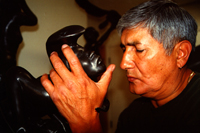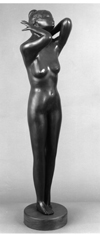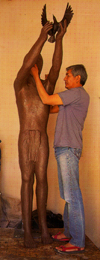Michael Naranjo - May/June 2002
- Details
- Last Updated: Sunday, 05 August 2012 19:12
We have a very special opportunity at Camp Brotherhood Symposium this year. Michael Naranjo will be a guest instructor on July 16-18.
“...Regarding ‘tools’ or ‘things to bring’, I always have my ‘tools’ with me, as I basically use my fingers and sense of touch; I rarely use conventional tools because I can’t always tell what the tool “sees”. I need to be in constant contact with my material, and though I encourage participants in my workshop to join me in this experience, participants are certainly welcome to use whatever else they are most comfortable with. Things that you need to bring to my workshop: your thoughts, your memories, your feelings, and, of course, your creative energy are all we really need to create. My wife, Laurie, and I are looking forward to experiencing Camp Brotherhood, and I am sure we will all have a great time...”
- Michael
Michael A. Naranjo comes to us from Santa Fe, New Mexico. He grew up on tribal land in Northern New Mexico. His mother was a potter, and it was through experimenting with her clay that he began the creative journey that would become his life. Ever since childhood, Michael had dreams of becoming a sculptor. When not involved with clay, Michael also did a lot of hunting and fishing with his brother, Tito. These natural “anatomy lessons” were to serve him well in later years, after he lost his sight.
In 1967, at the age of 22, Michael was drafted into the US Army, and sent to Vietnam. On January 8, 1968, Michael’s platoon was caught in an ambush in an open rice field. Michael was hit by a grenade and would never see again. Both eyes were enucleated and he lost most of the use of his right hand. Rather than deter Michael, however, his injury made him more determined to fulfill his childhood dream. He began sculpting again while lying in a hospital bed in Japan, waiting to heal. Michael began simply, by “creating” a worm — basically, starting over.
Known as “the artist who sees with his hands,” Michael has work displayed in numerous public and private collections across the country and in exhibitions nationally and internationally as well. His creations in bronze are representational, each one telling a story all its own. The patina he chooses is dark - the way he sees them.
Not being satisfied to merely create, Michael has gone on to share his story and his technique with others. He has served as a mentor for many people, young and old, disabled and not, service connected and civilian, for Michael’s story is one that many can relate to. Michael serves as an example of what can be accomplished if one puts one’s mind to the task. He has been an educator in the public schools, has presented hands-on workshops to people with disability around the country, and has given numerous talks on his life and his work to a variety of audiences. We at Northwest Stone Sculptors Association are honored and delighted to be able to spend time with him.
Michael has received numerous honors and accolades over the years. In 1976, he was presented with the “Governor’s Award for Sculpture” by Governor Jerry Apodaca. In1983, he was granted a papal audience at the Vatican where he presented Pope John Paul II with his piece, “Going Home”. In 1996, he was nominated by President Bill Clinton to serve on the Board of Trustees of the Institute of American Indian and Alaska Native Culture and Arts Development. If the purpose of art is to express and evoke emotion, Michael is an artist extraordinaire. Through his work, he has touched the lives of many on many different levels. Michael continues to work in his studio in his home in Northern New Mexico.
Michael will be part of the team of figurative instructors at Brotherhood and will guide us to connect with the sculptural process at a deeper and perhaps a more tangible level. He will be facilitating us with clay exercises, demonstrating how to do portraits in clay, and assist us with new approaches to bring to our work in stone.
You can email Michael directly: This email address is being protected from spambots. You need JavaScript enabled to view it..


